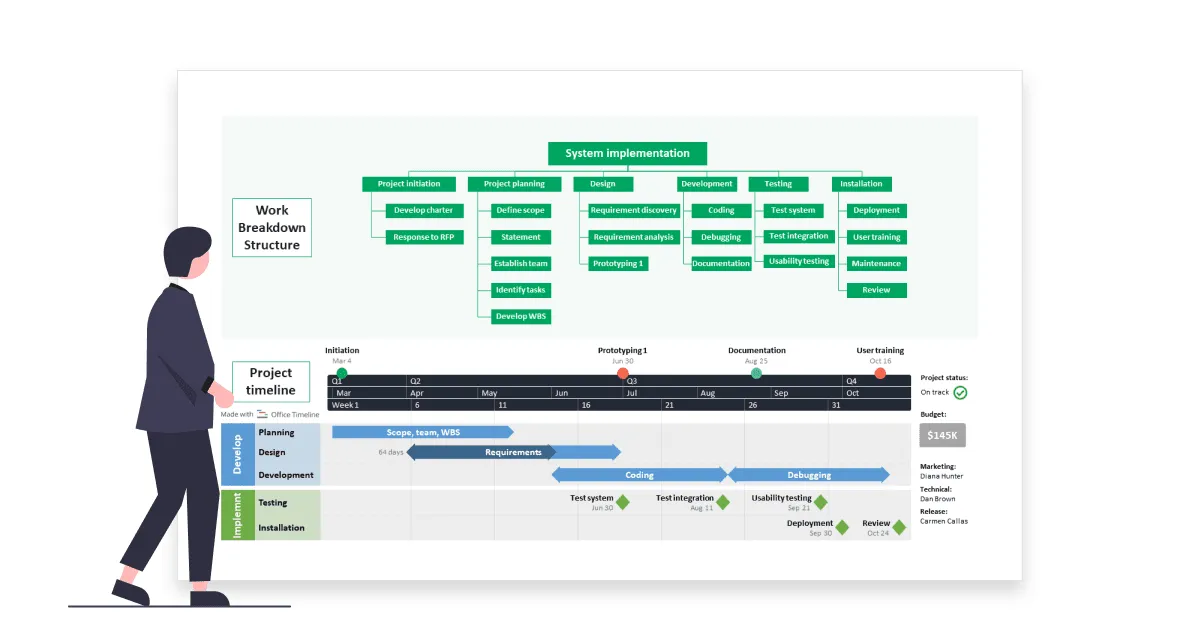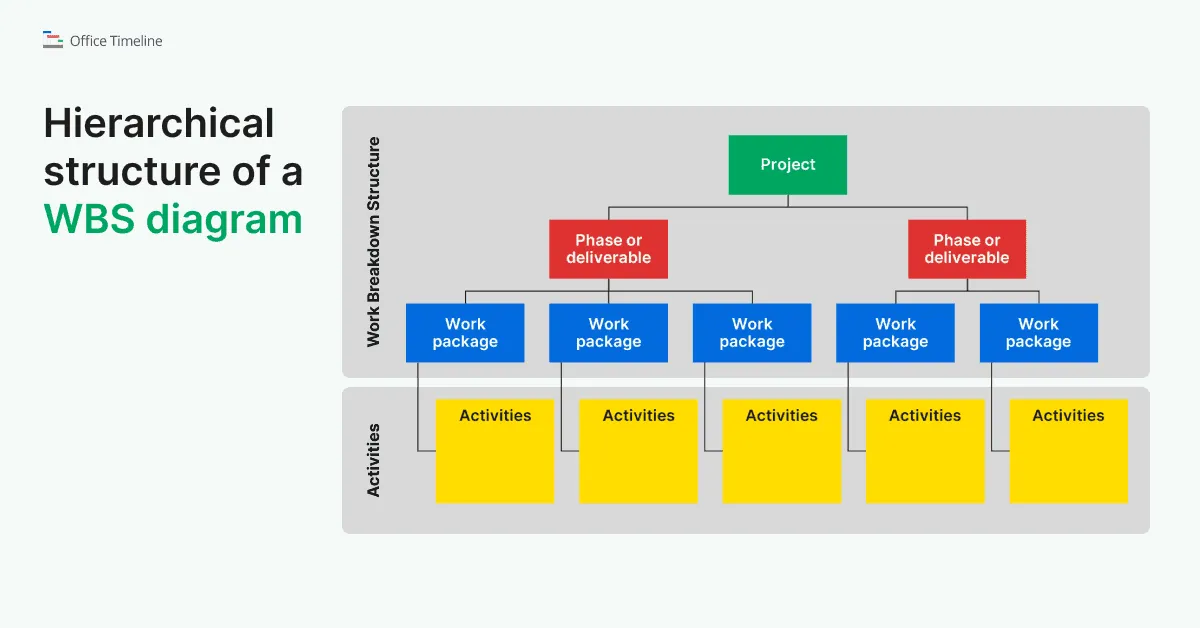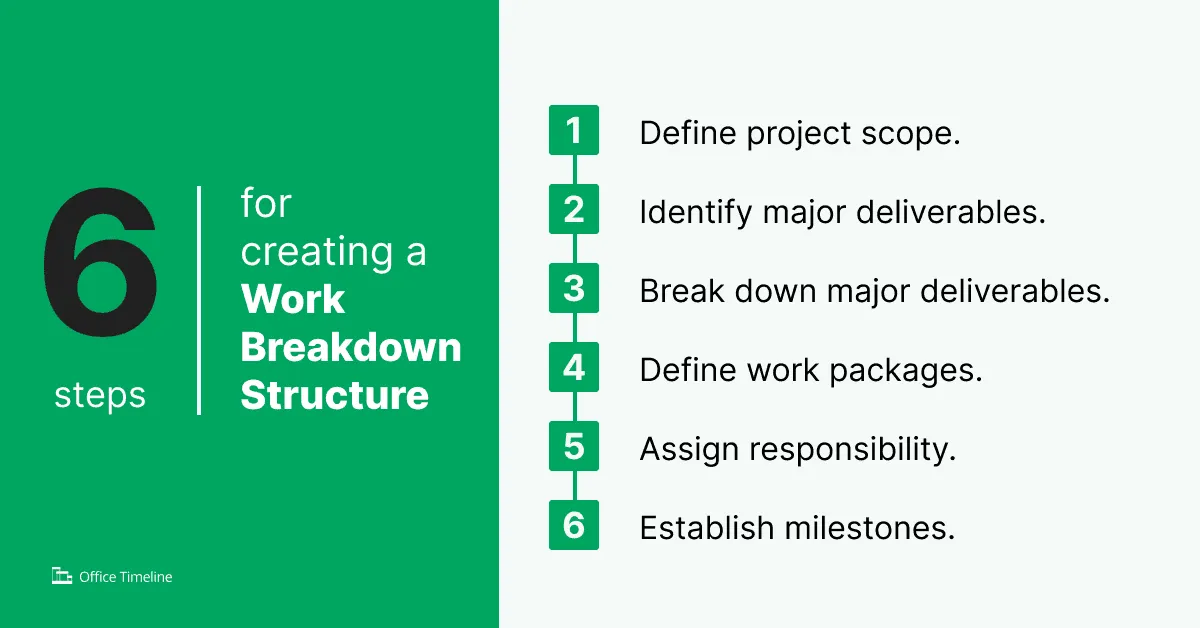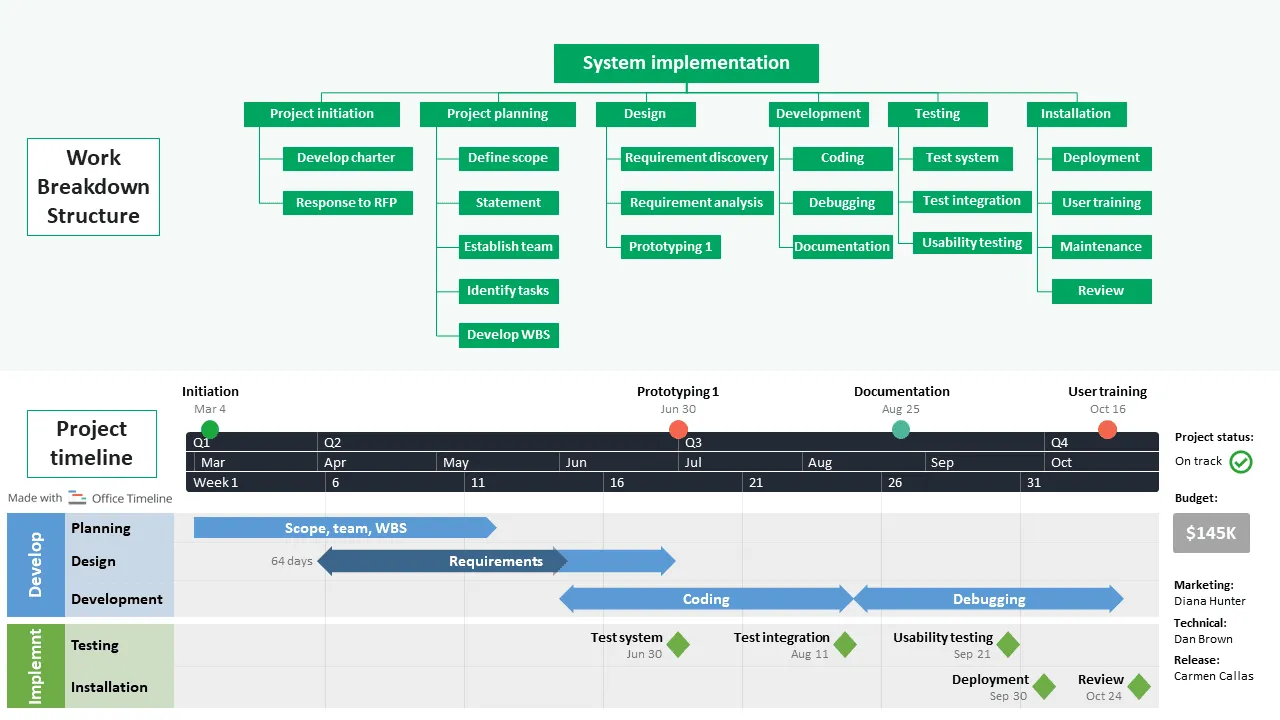The power of Work Breakdown Structures
Learn how a Work Breakdown Structure can help you manage your projects better and put it to work with our free downloadable template included.

Let’s face it, the road from project kick-off to effective delivery often comes with bumps – those gaps between what’s happening and what is expected. To effortlessly navigate the differences between the current course of action and the dream project scenario, you need a powerhouse framework, and the Work Breakdown Structure (WBS) is an excellent starting point.
The WBS isn’t just another project management acronym. It’s your compass to define and track project deliverables and all the components that make them happen. Picture it as your guide, keeping you on track and focused as you sprint towards the deadline.
Excited to learn more? In this article, we’re digging into the why and how to use WBS in project management, sharing hands-on tips on creating and putting it into action. What’s more, you get the chance to snag a free downloadable Work Breakdown Structure template that will help streamline your project planning efforts.
Ready to level up your project management skills? Let’s dive into the world of WBS.
1. Gap analysis and WBS in project management
Before delving into the intricacies of Work Breakdown Structures, let’s touch upon the concept of gap analysis in the context of project management.
Gap analysis involves evaluating the disparity between the real state of affairs and the desired results. It serves as a diagnostic tool that identifies deficiencies, areas of improvement, and opportunities for development within a project or organization. Once such aspects are highlighted, Work Breakdown Structures come into play to outline the steps necessary to bridge the gaps that hinder project success.
By breaking down complex initiatives into manageable components, a WBS emerges as a powerful ally to any project manager. It acts as a roadmap that provides a visual representation of all project parts, which ensures:
- Increased clarity and an ongoing view for management and team members into how the project progresses;
- Well-defined, specific, and measurable outcomes;
- Enhanced cost estimation and resource allocation;
- Improved risk management.
All this allows an in-depth understanding that lays the groundwork for informed decision-making and, ultimately, for effective project management.
To help you get started in documenting, managing, and tracking the details of your project, in this article you’ll find a free downloadable Work Breakdown Structure template that you can easily edit and customize in PowerPoint.
2. Understanding the Work Breakdown Structure
What is a Work Breakdown Structure and what is its purpose?
A Work Breakdown Structure is a systematic decomposition of the total scope of work in a project. Imagine it as a detailed and clear checklist that breaks your project into bite-sized pieces, making everything more manageable. It is like a roadmap that guides you through the underlying complexities of your initiative with ease.
Its main purpose? Helping you to define, execute, and track your project deliverables and all the nitty-gritty components that bring them to life in an organized manner. So, why should you want to use it? Because it keeps you laser-focused on what truly matters as you charge toward that deadline.
What are the key components of a Work Breakdown Structure?
A reliable work breakdown structure should include the critical elements of a project, along with its timeline, cost, and resources. The most useful WSB plans contain these primary components:
Work Packages
Work packages, the smallest units of work in a WBS, represent tasks essential for achieving specific deliverables. They form the foundational building blocks of the WBS, breaking down the project into actionable items.
Deliverables
Deliverables are tangible results or outputs of project phases or the project as a whole. They provide a clear depiction of what needs to be achieved, serving as benchmarks for project progress.
Subtasks
Subtasks constitute the detailed steps required to complete a work package. Offering granularity, subtasks provide a nuanced view of the work involved in each task, facilitating precise execution.
How is a Work Breakdown Structure organized?
A WBS follows a top-down approach, dividing the project into phases, deliverables, and work packages. This hierarchical structure ensures a systematic breakdown of the project scope, contributing to a more effective management of your projects.
In the world of project management, think of it as your project’s organizational backbone. It’s like crafting a detailed roadmap that starts with your project’s overarching goal and progressively zooms in on specific tasks.
Here are the main levels in the hierarchical structure of a WBS:
Level 1 - The big picture
At the top level, you have your project’s ultimate mission – the primary goal that encapsulates the entire undertaking. This serves as the foundation, outlining the comprehensive scope of your project.
Level 2 - Breaking it into phases
Moving down to the second level, imagine this as the chapters in your project story. Each chapter represents a major phase or aspect of your project. For instance, if your project involves building a rocket, these chapters could include Design, Construction, Testing, and Launch.
Level 3 - Detailed tasks (work packages)
Zooming in further, you reach the third level, where you encounter work packages. These are the specific tasks essential for the success of each phase. Continuing with the rocket example, under the Construction phase, you might identify work packages such as "Assemble rocket body" or "Install propulsion system."
Level 4 and beyond - Precision in action (subtasks)
As you delve even deeper, you uncover subtasks – the granular actions that breathe life into each work package. Using the "Install propulsion system" work package as an example, subtasks could include actions like "Connect fuel lines" or "Test engine performance."
In essence, the hierarchical structure of a WBS acts as a zoom-in feature for your project, systematically breaking down the overarching goal into manageable phases, tasks, and detailed actions. It serves as a reliable guide, leading you through the entire project journey, from the higher mission down to the minutest project intricacies.
To get a better idea of how the hierarchical structure of a WBS looks like, here is a generic example:
Now that we’ve seen how the hierarchical structure of a WBS can be illustrated, let’s have a look at the connection that can be established between this type of project management visual and the overall scope statement of a project.
3. What is the link between a Work Breakdown Structure and project scope statement?
The concept of project scope statement and that of Work Breakdown Structure are intricately linked together. While a project scope statement defines the overall project’s objectives, requirements, constraints, and milestones, the WBS visually maps the steps to achieve the set deliverables.
The Work Breakdown Structure provides clarity on project boundaries, preventing scope creep and ensuring alignment with project goals.
For a clearer explanation, let’s consider the following analogy:
Imagine you’re planning a big party. On one hand, the project scope statement is the detailed plan for your party, outlining everything you want to achieve, the goals of the party, and what’s included (or not included) in the celebration. On the other hand, the Work Breakdown Structure will be the step-by-step breakdown of all the tasks and things you need to make your party a success. It’s like having a checklist that helps you organize everything.
In line with this analogy, your project scope statement is where you decide what your party will include, like decorations, food, and entertainment. It sets the boundaries and defines what you’re aiming for. Once you establish these premises, your WBS would then take each big aspect of your party and break it down into smaller, manageable tasks. For example, if “decorations” is part of your scope, the WBS would break it down further into tasks like “buy balloons”, “hang streamers”, and so on.
In short, the project scope statement is like the master plan for your project, and the Work Breakdown Structure is the detailed roadmap that breaks down the plan into smaller, achievable tasks. Together, they make sure you understand what needs to be done and help you stay organized as you work toward your goals, whether it’s throwing a party or managing a complex project.
4. Why should you use a Work Breakdown Structure?
The benefits of employing WBS are multifaceted, and we’ll include below some of the most important.
Improved project planning
A well-constructed WBS facilitates comprehensive project planning by breaking down the project into manageable components. This ensures that every aspect of the project is considered and planned for, resulting in a more accurate timeline and resource estimation.
Enhanced resource allocation
A WBS allows project managers to identify resource needs for each work package, thus facilitating optimal resource allocation and utilization throughout the project lifecycle.
Clear communication and reporting
The visual representation of a WBS simplifies complex project structures, making it easier to communicate with team members, stakeholders, and clients. It provides a common language for all project participants, reducing the likelihood of misunderstandings.
Risk identification and management
A well-developed WBS helps project managers to identify potential risks by analyzing the individual components of the project. This proactive approach enables effective risk management throughout the project lifecycle, mitigating potential challenges.
Progress tracking and monitoring
The hierarchical structure of a WBS facilitates progress tracking at various levels. Project managers can monitor the completion of work packages and milestones, which ensures that the project stays on course and deviations are addressed promptly.
Given the many benefits that a WBS can bring to the table, let’s learn how to craft one such project visual.
5. How do you create a Work Breakdown Structure?
To create an efficient WBS of your project, follow the steps below:
Step 1. Define project scope.
Clearly articulate the project scope, outlining what needs to be achieved and the desired outcomes. This foundational step sets the stage for the entire WBS creation process.
Step 2. Identify major deliverables.
Break down the project into major deliverables, ensuring that each one contributes to the overall project objectives. These deliverables serve as milestones and benchmarks for progress.
Step 3. Break down major deliverables.
Divide your main deliverables into smaller, more manageable components, creating a hierarchical structure. This step involves breaking down the project into phases and identifying the key components of each phase.
Step 4. Define work packages.
Specify the detailed tasks and activities required to complete each work package. This level of granularity ensures that each component of the project is thoroughly understood and planned for.
Step 5. Assign responsibility.
Allocate responsibilities to team members for each work package, ensuring clear lines of accountability. This step fosters a sense of ownership among team members and enhances collaboration.
Step 6. Establish milestones.
Identify key milestones to track progress and celebrate achievements throughout the project. Milestones serve as critical checkpoints, allowing project managers to assess whether the project is on track.
Along with the above step-by-step guide on how to create a work breakdown structure, you should also keep the following best practices in mind:
- Involve stakeholders from the beginning to gather diverse perspectives and ensure comprehensive project coverage.
- Use action verbs when defining work packages for clarity and specificity.
- Ensure that work packages are measurable and verifiable, providing a clear basis for progress assessment.
- Keep the WBS flexible to accommodate changes during the project lifecycle, allowing for adaptability in response to evolving project needs.
While mastering the best practices for developing a Work Breakdown Structure is crucial, it’s equally important to be aware of common pitfalls. Let’s explore next the key mistakes to avoid when doing so.
6. Common mistakes to avoid when developing a Work Breakdown Structure
Here are some things you need to be looking out for:
Lack of stakeholder involvement
Failure to involve key stakeholders in the WBS development process can lead to misunderstandings, oversights, and ultimately, project failure. Stakeholder input is invaluable in ensuring that the WBS aligns with project goals and expectations.
Overlooking dependencies
Neglecting to identify and address task dependencies can result in project delays and complications. Understanding the relationships between different components of the project is crucial for seamless execution.
Not reviewing and updating regularly the WBS
A static WBS can quickly become outdated, rendering it ineffective in guiding the project through changes and challenges. Regular reviews and updates are essential to reflect any alterations in project scope or requirements.
7. Free Work Breakdown Structure template
Armed with the knowledge of the dos and don’ts of creating a WBS, you can now take the first step towards organized and successful projects. To help you with that, we’ve included below a free downloadable Work Breakdown Structure template that you can easily customize in PowerPoint to simplify your project management process.
Using and updating the Work Breakdown Structure PowerPoint template
Our versatile Work Breakdown Structure template features a sample hierarchical structure diagram that you can update with your own data. This will help you efficiently break down and organize your work into more manageable tasks. It also includes a timeline that helps you to visually map the chronology of your work packages, providing a comprehensive overview of your project’s progress.
Crafted as a native PowerPoint slide, this downloadable WBS template can be easily shared and edited by anyone with access to the popular presentation tool. Its visual design facilitates quick comprehension of key project data, making it ideal for presentations to team members, executives, and stakeholders. The timeline template was built with the Office Timeline add-in.
The tool is designed as a PowerPoint plug-in, which means you can edit our WBS sample or create other similar ones directly in PowerPoint. You can quickly update and customize it with your project details using the Office Timeline free trial.
In the ever-evolving landscape of project management, the Work Breakdown Structure emerges as a powerful tool for all project professionals. Its ability to enhance planning, resource allocation, communication, risk management, and progress tracking makes it a cornerstone of successful project execution.
A well-crafted WBS will provide you not only with an overall project plan, but also a step-by-step guide on how to steer your project through its various phases with clarity, precision, and adaptability. To project managers seeking efficiency and success, the implementation of a robust WBS is a transformative step.
To kickstart your project planning work, download our free Work Breakdown Structure template and give your projects the structure they deserve.
9. FAQs about Work Breakdown Structures
Find below the short answers to some of the most common questions about work breakdown structures.
According to the Project Management Body of Knowledge, a Work Breakdown Structure (WBS) is “the hierarchical decomposition of the total scope of work to be carried out by the project team to accomplish the project objectives and create the required deliverables”. It is an important project management tool as it provides a systematic approach to breaking down complex projects into manageable components, aiding in planning and execution.
A WBS helps in project planning by breaking down the project into smaller, more manageable components. This facilitates accurate planning, resource allocation, and progress tracking, contributing to successful project execution.
The key components of a WBS include work packages, deliverables, and subtasks. Work packages are the smallest unit of work, deliverables are tangible project outputs, and subtasks are detailed steps required to complete work packages.
The process of creating a clear Work Breakdown Structure involves the following steps:
- Defining project scope;
- Identifying major deliverables;
- Breaking down major deliverables;
- Defining work packages;
- Assigning responsibility;
- Establishing milestones.
By clearly dividing the body of project work that needs to be done into smaller, more manageable units (work packages), a WBS enhances resource allocation because it allows project managers to identify resource needs for each work package. This ensures optimal resource utilization and contributes to the overall efficiency of the project.
Learn more about how a WBS can help you plan and manage your projects better in our section on the benefits of using a Work Breakdown Structure.
A well-developed WBS aids in risk identification because it analyzes each component of the project individually. This approach helps you spot deficiencies and risks more easily throughout the project lifecycle, which in turn enables you to proactively mitigate potential challenges.
Among the most common mistakes to avoid when creating a WBS are included:
- The lack of stakeholder involvement;
- Overlooking task dependencies, and
- Not reviewing and updating the WBS regularly.
All these can lead to misunderstandings, delays, and outdated project plans.
Project management software automates the process of creating and managing a WBS, providing tools for collaboration, progress tracking, and real-time updates. Using such time-saving tools streamlines the project management workflow and enhances overall efficiency.
There are several popular project management tools that can assist you in WBS creation, such as Microsoft Project, Wrike, and Asana. If you aim for a more visual output that you can easily edit, update, and share as often as necessary, Office Timeline’s add-in for PowerPoint can prove a reliable option.
The bottom line is that you need to choose a tool that aligns with your project management needs and preferences.
To ensure that your WBS accurately reflects the status of your project, you need to review and update it regularly. Aim for periodic reviews, especially during project milestones or when there are changes in project scope or requirements. This ensures the WBS remains precise and relevant throughout the project lifecycle, contributing to successful project execution.
Create your next work breakdown structure diagram with our free WBS template that can be updated as frequently as required. Simply download it with a click, open it in PowerPoint, and automatically update it according to your own data and style preferences using the free 14-day trial of the Office Timeline add-in.
Tim is Co-Founder & CEO of Office Timeline, a Seattle-based start-up that aims to rid the world of boring, uninspiring meetings.
Turn project data into professional timelines
Get the advanced features of Office Timeline free for 14 days.






